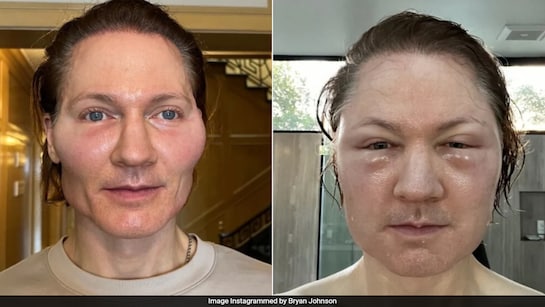Bryan Johnson Tech Millionaire’s Anti-Aging Experiment Goes Awry
Bryan Johnson, a millionaire tech entrepreneur and a prominent figure in the longevity movement, has built his reputation on pushing the boundaries of human health and lifespan. Through his highly publicized Project Blueprint, Johnson aims to reverse aging and extend human life expectancy to 150 years. While his endeavors have often sparked intrigue and controversy, his latest experiment, “Project Baby Face,” resulted in an unexpected and severe allergic reaction, leaving his face swollen and red. This incident sheds light on the risks and ethical concerns associated with extreme anti-aging experiments.
On November 14, Bryan Johnson shared a dramatic photo on Instagram, revealing his swollen, red face. The striking image was the result of an experimental procedure where fat from a donor was injected into his face. Dubbed “Project Baby Face,” the experiment aimed to restore a youthful appearance after Johnson’s strict 1,950-calorie diet left him with a gaunt and hollowed facial structure.
“I got really lean and lost a lot of fat—especially in my face. My biomarkers were improving, but I looked gaunt,” Johnson explained in his Instagram post. He admitted that his skeletal appearance sparked concerns, with people speculating that he might be ill or on the brink of death. Determined to address the issue, Johnson opted for the experimental fat-injection procedure to regain a fuller, youthful look.
A Severe Reaction
However, the outcome was far from what Johnson had anticipated. Just 30 minutes after the procedure, his face began to swell alarmingly. “Immediately following the injections, my face began to blow up,” he shared. “And then it got worse, and worse, and worse until I couldn’t even see. It was a severe allergic reaction.”
Despite his condition, Johnson attended a pre-scheduled meeting with a Bloomberg reporter, cautioning him beforehand that his appearance had drastically changed. Over the course of seven days, the swelling subsided, and Johnson’s face returned to its normal state. However, the dramatic reaction underscored the potential dangers of such unconventional anti-aging experiments.
A History of Unconventional Methods
This isn’t the first time Johnson’s radical approaches to longevity have made headlines. Through his Project Blueprint, he has undertaken numerous experimental procedures, including controversial methods that blur the line between science and speculation.
1. Young Blood Transfusions
One of the most polarizing aspects of Johnson’s regime is his use of “young blood” transfusions. In this procedure, he receives plasma from his teenage son in hopes of rejuvenating his body and slowing the aging process. The FDA has not approved this controversial method, and it has drawn significant criticism from medical experts who question its efficacy and ethical implications.
2. Strict Diet and Supplements
Johnson adheres to a rigid daily diet of precisely 1,950 calories, supplemented by a range of Blueprint-branded vitamins and minerals. While his diet has reportedly improved his biomarkers, it has also caused extreme weight loss, contributing to the gaunt appearance that prompted Project Baby Face.
3. Gene Therapy and Other Experimental Procedures
Johnson regularly undergoes gene therapy injections as part of his broader strategy to combat aging. These experimental treatments aim to optimize cellular health and delay the onset of age-related diseases. However, the long-term effects of such therapies remain largely unknown, making them a contentious component of his anti-aging crusade.
The Science and Risks Behind Anti-Aging Experiments
Johnson’s efforts to reverse aging represent the cutting edge of longevity science, but they also highlight the potential risks of unproven treatments. Fat injections, for example, are not without complications. Adverse reactions, including severe allergies and infections, can occur when foreign substances are introduced into the body.
Similarly, procedures like young blood transfusions lack robust scientific validation, and experts caution against their use outside of controlled clinical trials. While Johnson’s experiments provide valuable data for researchers, they also raise ethical questions about the lengths to which individuals should go to defy aging.
Despite the challenges, Johnson remains unwavering in his mission to extend human lifespan and enhance healthspan. Following the allergic reaction, his team began planning their next attempt at achieving the goals of Project Baby Face. For Johnson, setbacks are part of the journey, and he views each experiment as a stepping stone toward scientific breakthroughs.
“I believe in the power of experimentation to uncover new possibilities,” Johnson stated. “Sometimes things don’t go as planned, but we learn, adapt, and move forward.”
Johnson’s endeavors represent the forefront of a growing movement to redefine aging and human health. His work, though controversial, underscores the potential of scientific advancements to transform how society views aging. However, it also raises important questions about safety, regulation, and ethics in experimental medicine.
1. Innovation vs. Risk
While groundbreaking technologies hold the promise of extending human life, they also come with significant risks. Experiments like Johnson’s demonstrate the fine line between innovation and recklessness, emphasizing the need for rigorous testing and oversight.
2. Accessibility and Equity
Longevity science often caters to the wealthy, leaving questions about whether such advancements will ever be accessible to the broader population. Johnson’s high-profile experiments highlight the gap between cutting-edge research and practical applications for everyday people.
Bryan Johnson’s latest anti-aging experiment, though dramatic and unsettling, reflects his relentless pursuit of longevity. While Project Baby Face resulted in a severe allergic reaction, it also serves as a reminder of the risks inherent in pushing the boundaries of science.
As Johnson continues to explore new frontiers in longevity, his work will undoubtedly spark debates about the ethics, safety, and accessibility of anti-aging technologies. Whether his experiments ultimately succeed in reshaping the human lifespan or serve as cautionary tales, they remain a fascinating glimpse into the future of health and innovation.


Comments are closed.